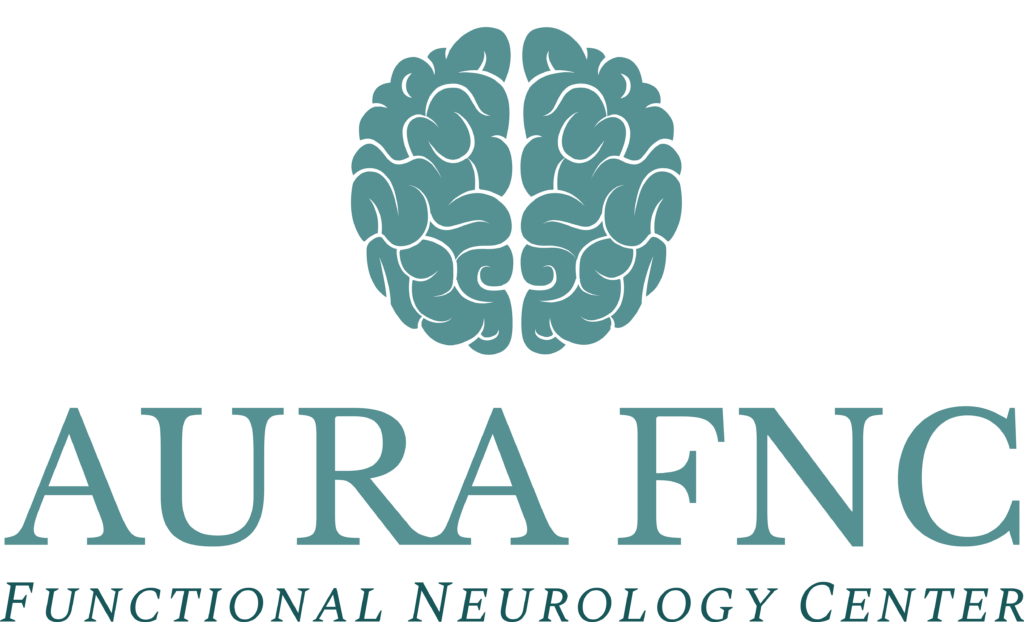Postural Orthostatic Tachycardia Syndrome (POTS)
What is POTS?
Postural Orthostatic Tachycardia Syndrome (POTS) is a subset of dysautonomia, a disorder affecting the autonomic nervous system, and is one of the neurological disorders we specialize in at the Aura Functional Neurology Center (Aura FNC). One hallmark feature of POTS is a rapid heart rate that occurs when transitioning into an upright posture or with prolonged standing. When individuals with POTS stand up, they experience an abnormal increase in heart rate, typically exceeding 30-40 beats per minute or reaching a rate of over 120 beats per minute within 10 minutes. This dysregulation in heart rate is accompanied by a range of symptoms indicative of autonomic dysfunction, impacting various bodily functions.
Our patients at Aura FNC with POTS can often experience symptoms such as dizziness, lightheadedness, near-fainting (pre-syncope), fainting (syncope), chronic fatigue, and cognitive difficulties such as word finding and memory. In addition to the cardiovascular aspects, individuals with POTS may experience challenges in regulating blood flow to the brain (poor circulation in hands and feet) contributing to cognitive impairment.
The autonomic dysfunction in POTS can extend beyond heart rate abnormalities, affecting the entire autonomic nervous system and leading to an array of symptoms that significantly impact daily functioning. The diverse nature of POTS symptoms and the complexity of this condition require a comprehensive understanding to guide effective management strategies. Dr. Diana Tyler creates tailored POTS neurorehabilitation programs for each patient’s unique needs that come through our treatment programs at Aura FNC.

Dr. Diana Tyler DC, DACNB
Founder of Aura Functional Neurology Center with experience treating Postural Orthostatic Tachycardia Syndrome (POTS) patients at our office located right outside the Atlanta area in Cumming, Georgia. Doctor of Chiropractic and Functional Neurologist. Graduate of Palmer College of Chiropractic and a Diplomate of the American Chiropractic Neurology Board.

Understanding orthostatic intolerance and its relation to POTS
Orthostatic intolerance is a central aspect of POTS, representing the body’s inability to regulate blood pressure and heart rate appropriately during changes in position, such as standing up. This intolerance leads to symptoms like dizziness, lightheadedness, and fainting. The underlying cause is often attributed to dysfunction in the autonomic nervous system, which controls involuntary bodily functions. In POTS, this dysfunction results in an exaggerated heart rate response to orthostatic stress. Understanding orthostatic intolerance is crucial for recognizing the core mechanism behind POTS and tailoring interventions that address the autonomic dysregulation associated with this condition.
Brief overview of blood volume and blood flow in POTS patients
POTS patients often exhibit abnormalities in blood volume and blood flow regulation. Reduced blood volume can contribute to symptoms like low blood pressure, while impaired blood flow regulation may lead to inadequate perfusion of vital organs such as the gut (leading to impaired motility and chronic constipation). These factors play a role in the characteristic symptoms of POTS, emphasizing the importance of understanding the cardiovascular dynamics involved in this syndrome.
POTS Symptoms and Diagnosis
Individuals with Postural Orthostatic Tachycardia Syndrome (POTS) often experience a wide array of symptoms, reflecting the multifaceted nature of autonomic dysfunction. Common symptoms include a rapid and excessive increase in heart rate upon standing, reaching levels that can lead to dizziness, lightheadedness, and, in severe cases, fainting. Fatigue is another prevalent symptom, often persisting throughout the day and significantly impacting daily activities. This fatigue does not improve with sleep.
Cognitive difficulties, commonly referred to as “brain fog,” can manifest as impaired concentration, memory lapses, difficulty processing information, and struggle with word finding making even communication difficult. Individuals with POTS may also report headaches, migraine, chest discomfort, shortness of breath, and a sense of weakness and core shakiness. The variability in symptom presentation highlights the need for a comprehensive evaluation to capture the diverse ways in which POTS can impact an individual’s well-being.
Diagnostic criteria for POTS
The diagnosis of POTS is based on specific criteria established by healthcare professionals. One key criterion is a heart rate increase within 10 minutes, or sometimes even within seconds, of standing. This abnormal response should be accompanied by typical symptoms like dizziness or lightheadedness. It’s essential to rule out other medical conditions that could mimic POTS symptoms, such as dehydration, hypoglycemia, or cardiac issues.
Tilt-table testing is a common diagnostic tool, involving placing the individual on a table that tilts to simulate changes in posture. Additionally, bedside autonomic function testing and a thorough medical history are integral components of the diagnostic process.
To diagnose POTS, heart rate and blood pressure are typically measured after the patient has been in a supine position for 5–10 minutes and measured after standing for 1 minute, 3 minutes, 5 minutes, 8 minutes, and 10 minutes. To diagnose excessive orthostatic tachycardia, necessary for POTS, patients must the following criteria – a sustained heart rate increase of at least 30 beats/min (for adults) or at least 40 beats/min (for patients aged 12–19 years) in at least 2 of the standing readings with no associated systolic blood pressure changes below 20 mm Hg.
The establishment of clear diagnostic criteria ensures a standardized approach to identifying POTS and guides healthcare professionals in differentiating it from other conditions with similar symptomatology.
While we do not have a tilt table at Aura FNC, we have other methods of identifying and diagnosing POTS symptoms and often refer to cardiology in your local area. With current rises in these diagnoses globally, they often have a long waitlist, and many cases patients need treatment ahead of time.
POTS Rehabilitation Programs
Dr. Diana Tyler offers postural orthostatic tachycardia syndrome (POTS) treatment in the form of a 5-day, 10-day, or 15-day brain rehabilitation program at the Aura Functional Neurology Center office in Cumming, Georgia. These rehabilitation programs are customized to patients based on their symptoms and unique needs from passive therapies to the office environment. Many of our patients who come for POTS treatment at Aura FNC will travel from other cities in Georgia, fly in from other states around the U.S.A., and some will even travel internationally for our POTS rehabilitation programs.
Dr. Diana Tyler treats POTS from a functional and neurological perspective using neuroplasticity and brain training to positively influence the complex interactions between genetics, environmental factors, and changes in brain chemistry that surround POTS. She focuses on strengthening the area of the brain dysfunction (cortex and brainstem) that is contributing to your POTS symptoms while also addressing the contributing structural and metabolic factors.
POTS treatment at Aura FNC involves a combination of lifestyle and dietary modifications, nutritional support, neurological rehabilitation, and treatment of the cervical spine. Our approach is based on Chiropractic Functional Neurology and the latest research in clinical neuroscience.
Aura FNC, a private practice with limited capacity, accepts a restricted number of patients annually for our POTS rehabilitation programs. This allows for personalized 1:1 sessions with Dr. Diana Tyler, offering 15, 30, or 45 hours of individual treatment across 1, 2, or 3 weeks in a private office setting.
POTS Causes and Risk Factors
POTS can have various underlying causes, including small fiber neuropathy, hyperadrenergic POTS, and deconditioning. Small fiber neuropathy involves damage to small nerve fibers that regulate blood flow and heart rate. Hyperadrenergic POTS is characterized by elevated levels of norepinephrine, a neurotransmitter that affects heart rate and blood pressure. Deconditioning, resulting from prolonged periods of inactivity or bed rest, can contribute to the development of POTS symptoms.
Impact of autoimmune diseases on POTS development
Certain autoimmune diseases are associated with an increased risk of developing POTS. Conditions like Ehlers-Danlos syndrome, Sjögren’s syndrome, and lupus can contribute to autonomic dysfunction, disrupting the body’s ability to regulate heart rate and blood pressure. Understanding the relationship between autoimmune diseases and POTS is crucial for targeted management strategies, so we always do a thorough check of your medical history when you’re a POTS patient at Aura FNC.
Role of viral infections in triggering POTS symptoms
Viral infections, particularly those affecting the nervous system, can serve as triggers for POTS development. Infections such as Epstein-Barr virus (cause of mono) and COVID-19 have been implicated in initiating autonomic dysfunction and contributing to the onset of POTS symptoms. This highlights the importance of considering infectious triggers when evaluating individuals with POTS and tailoring treatment approaches accordingly.
POTS Triggers
Various factors can act as triggers for POTS symptoms, exacerbating the condition in affected individuals. Common triggers include prolonged standing, heat, dehydration, low blood sugar and intense physical activity. Stress and hormonal fluctuations, especially during menstruation, may also contribute to symptom exacerbation. Identifying and managing these triggers is integral to developing effective treatment plans and improving the quality of life for individuals with POTS.
- Prolonged standing:
Extended periods of standing can exacerbate POTS symptoms, leading to an abnormal increase in heart rate and associated discomfort. - Heat:
Exposure to elevated temperatures or hot environments may trigger symptoms in individuals with POTS making it difficult to manage symptoms in the summer. - Dehydration:
Insufficient fluid intake can worsen POTS symptoms, emphasizing the importance of maintaining adequate hydration. Hydration includes proper replenishment of sodium and electrolytes. - Intense physical activity:
Vigorous exercise or strenuous activities can act as triggers for POTS symptoms, potentially leading to rapid heart rate and lightheadedness. - Stress:
Emotional or psychological stressors can contribute to symptom exacerbation in individuals with POTS. Patients may develop anxiety secondary to POTS. - Hormonal fluctuations:
Changes in hormonal levels, particularly during ovulation and menstruation, may influence POTS symptoms in affected individuals. - Certain medications:
Some medications, such as vasodilators and certain stimulants, can impact blood pressure and heart rate regulation, potentially influencing POTS symptoms. - Illness or viral infections:
Underlying illnesses or viral infections, especially those affecting the nervous system, can serve as triggers for the onset or exacerbation of POTS. symptoms. - Postprandial state:
Eating meals, particularly larger ones triggers symptoms in some individuals with POTS, due to changes in blood flow during digestion. - Orthostatic stress:
Rapid changes in body position, such as standing up quickly, can provoke symptoms associated with orthostatic intolerance in individuals with POTS. Most notable upon waking due to a prolonged supine (lying) position when asleep.
